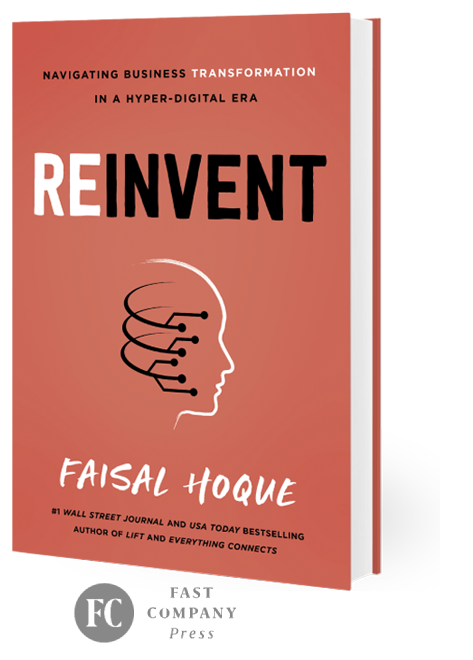Reinvention Involves Much More Than Technology
[This article is adapted from the book REINVENT (Fast Company, 2023) by Faisal Hoque.]
 The case for transforming your business or organization leveraging digital technology is undeniably compelling—so powerful, in fact, that even the briefest review of the advantages and opportunities seems needlessly redundant. What is anything but repetitive, however, is what it takes to get you where you want to go. Moreover, it isn’t quite the checklist that many of us might expect.
The case for transforming your business or organization leveraging digital technology is undeniably compelling—so powerful, in fact, that even the briefest review of the advantages and opportunities seems needlessly redundant. What is anything but repetitive, however, is what it takes to get you where you want to go. Moreover, it isn’t quite the checklist that many of us might expect.
True, you need an understanding of the essential technology involved (whether that will be you or some other tech-savvy individual). You need to know the optimal order in which things should take place. You should also have a clear set of benchmarks to track your progress and make certain that progress is occurring when and how it should.
But transforming your business involves a great deal more than unplugging this and plugging in that. It takes careful thought and a good deal of introspection. That’s because Transformation, however focused on technical aspects, also involves a sweeping reinvention of a great deal—if not most—of your organization, including aspects that you may not expect.
That’s just one of the many reasons why digital transformation falls short or outright fails. The overall scope of change can be simply enormous. Any company which fails to recognize that reality and plan accordingly is likely going to endure an effort characterized by struggle and missteps—or worse, complete disaster.
When leaders think about digital transformation, they inevitably focus their thoughts on the technology itself—understandably so.
But there’s much more to digital transformation than just the tech—so much, in fact, that ignoring it or even paying it insufficient attention can doom otherwise well planned transformative endeavors.
Digital transformation allows organization to shift their business models, processes and organizational culture with digital technologies to adapt to changing customer behaviors. But that opportunity mandates a broader view than just the tech itself. Successful digital transformation can flourish or flounder based on a leader’s ability to move away from a focus on management and toward one of leadership.
Looked at in a different light, digital transformation success relies on the right kind of culture. Leadership, planning, thoughtful execution and a commitment to a fresh mindset are every bit as critical to success as the right technology. Consider:
- Would you characterize your company as forward thinking or more focused on the past?
- Does your company do things because they’ve always been done that way?
- Is cross communication between departments encouraged or ignored?
- Is your company reasonably comfortable with risk or does it avoid it whenever possible?
- Does your organization welcome input from as many as possible or adhere more to the proverbial party line?
- Would you describe your company as adaptable or flexible?
By now, you can see where these and other similar questions are headed. To implement a genuinely effective transformation that includes a digital element, a welcoming culture must be in place, not merely to absorb the change, but to drive it forward as well. Still, the steep failure rate of digital transformation projects testifies to the reality that many leaders repeatedly approach the challenge with misaligned focus and priorities. One obvious candidate is the distorted view many leaders have of technology—as an absolute savior that will correct everything else that’s wrong with an organization. It can certainly help but approaching it as a panacea is an almost certain misstep.
Yet another source of failure lying in wait is treating technology with a plug and play attitude. Buy it, install and off it goes. End of story. As many companies have found to their discouragement, technology cannot even come close to its potential without constant attention with regard to funding, personnel, evolution and other factors. Moreover, technology has to be closely aligned with a company’s core mission, vision, culture and strategic objectives. Otherwise, it can be doomed to be a standalone disaster.
But that also hints at what might well be the most dangerous cause of all. Many leaders chronically fail to see—let alone appreciate—the absolute scope of what reinvention entails. Again, it’s a mistake to see technology as a simple add on. Rather, the implementation of digital technology carries ramifications throughout all areas of an organization. Leaders need to recognize that digital transformation isn’t just going to change what you do—it’s going to change how you think and act in profound ways, including your culture, processes, priorities and the very heart of your organizational strategy and direction.
The Way Forward
Let me summarize below what I have learned over 30 years about embarking on the journey of transformation. When I use the word journey, I mean to emphasize that reinvention never has any sort of fixed end point or conclusion. Rather, it’s an ongoing pilgrimage—one characterized not just by obstacles to be met and overcome but also by a fresh array of opportunities that each step along the journey continually presents.
These lessons are perhaps more valuable now than ever before. Leaders must embrace the following:
1. Follow the money. They must focus on the business and understand how it creates value. Leaders must understand the business strategy: Regarding each product market, is the firm in an exploratory or exploitative posture? This assumes that the organization has a strategy that is well articulated and supported by appropriate structures, processes, and information.
2. Know that managing technology is as important as the technology itself. The next generation of leaders will understand, or should if they want to succeed, that they must invest in managing technology as well as in the technology itself. If there is any remaining doubt today, there will not be in the future; technology, per se, is an equalizer. Only in the management of it can firms eke out an advantage.
3. Understand what technology does. Unless they appreciate that technology often plays a critical role in establishing or maintaining a strategic position, future leaders may well spend inappropriately. But that appreciation must evolve to an understanding of how the various types of technology—those that enable transactions, decisions, or relationships, for example—contribute to an organization’s strategic actions. More often than not, in the first half century of technology, it was thought about only tactically.
4. See through walls. Tomorrow’s leaders will be far more comfortable with deriving value through partnerships and other types of engagements. They must understand the role technology plays in enabling these partnerships and learn to manage the technology that stretches across internal organizational boundaries.
5. Manage business and technology as one. The moments of dissension and the finger-pointing at failures will disappear as executives come to see that business technology failure is often due to weak or nonexistent business strategy or failure to create a business-driven technology strategy. Alignment will increasingly be seen as only the first step; it will occur to all that the design and management of business cannot be done apart from the design and management of technology.
6. Scrap the org chart. We are already seeing the blending of corporate roles. It will be commonplace in the future. Leaders will have to be comfortable in both the business and technology realms. This re-identity is already underway.
7. Get underneath the hood. Leaders must be able to discern business processes below the overarching posture of an organization that advance strategy. Moreover, they must see technology as part and parcel of these processes; the two are inseparable. This is going to require untying the functional straitjackets in which many organizations have existed.
8. Get comfortable with speed. Is it too much of a cliché to say that everything will move faster and faster, that interconnectivity makes the whole world our playing field, and that we must give up command and control so that our people on the edges of the organization can react to events in real time? And that this is an entirely new way of thinking about management and leadership? And that even if we pay lip service to it today, it will be very hard to accomplish?
Above all, what really matters moving forward is your understanding and recognition of the scope of change, in which you are a valuable player. Armed with that powerful mindset, you’ve positioned yourself to be just as aware of how different your organization will look in the future—and how you can adapt to help that journey continue toward growth and further success.
© 2022 by Faisal Hoque. All rights reserved.












